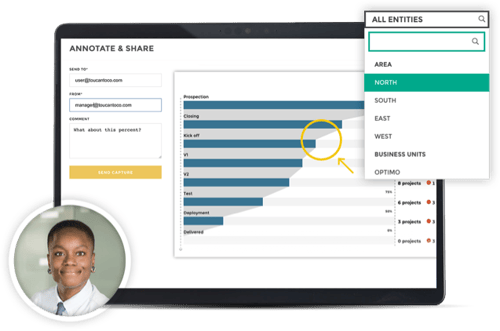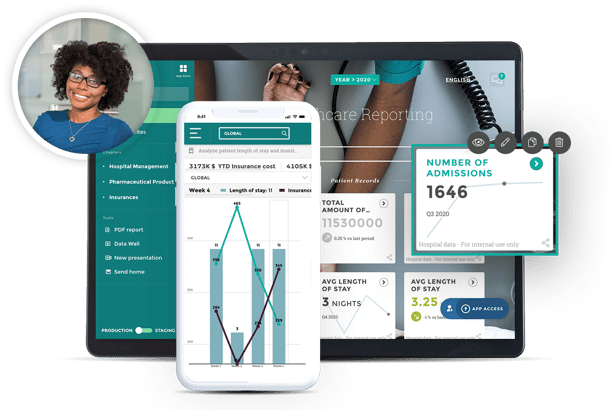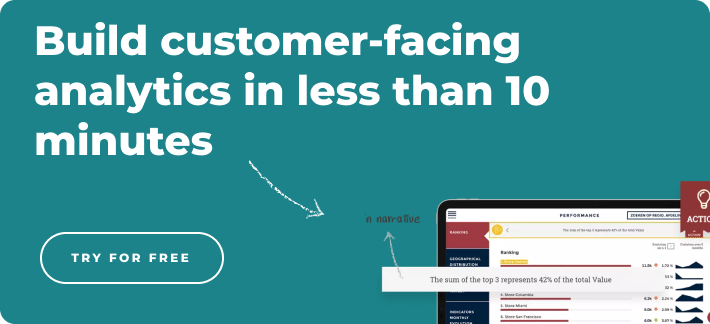Customer-Facing Analytics (CFA) - what is it?
In the past few years, analytics has moved beyond internal use because more data is collected each day and treated as an asset. As a result, customer-facing analytics are becoming increasingly popular – both for products to embed and as a feature requested by customers. Traditional business intelligence (BI) allows for ad hoc analysis and self-service, whereas customer-facing analytics provide end users with a packaged experience. In customer-facing analytics, data producers (enterprises who own the data) and data consumers (end users or customers) have the opportunity to interact with one another. Data and visualizations enable interactive analysis within the bounds of a packaged experience in customer-facing analytics by defining and delivering visualizations to the end user. The delivery of customer-facing analytics can take many forms, such as interactive dashboards, web applications, or mobile applications. Various actionable insights and methods of generating revenue become significant with the shift in analytics workloads toward customer-facing analytics.

Key Considerations for delivering Customer facing analytics:
- Determine the insights that customers require and the data that is required to deliver these insights in order to meet their needs.
- Design data models that are prescriptive, yet extensible, in order to meet the current and future needs of customers.
- Deliver analytics in a variety of formats according to the customer's needs.
- Establish clear expectations regarding the quality of the data and the response time. Customer-facing analytics must be performance-driven.
- Make sure that insights can be accessed securely, and ensure that they are scalable and available.
In order to ensure a proper set of expectations, it is necessary to define service levels for customer-facing analytics. Service levels can be used to agree upon the freshness of data, the response time to queries, data governance, etc. Depending on the end customer, customer-facing analytics can take different forms. For example, a personal dashboard in a gaming app, activity tracking in a fitness tracker, or an inventory tracking application that is available to suppliers are all examples of customer-facing analytics.
Customer-Facing Analytics Features
Ensure that any solutions you are considering include the following customer-facing analytics capabilities:
Seamless integration – Ideally, your customer-facing analytics solution should seamlessly integrate with all platforms, whether they are data warehouses, ERP applications, SaaS, or any other. Choose a solution that has been designed specifically for embedding and will not add additional weight or complexity to the development process.
Cloud-based – As embedded analytics continues to develop, one of the most significant trends is the use of cloud-based data warehouses which makes it possible to run distributed applications across multiple cloud infrastructures. Toucan has an in-built simple connector system for all the major cloud-based data storage systems.
Connectivity – Choose an embedded analytics solution that can integrate all the data sources you would need to make the best use of your client-facing analytics solution. It isn't worth investing in if it can't. Toucan has connectors for over 100 data sources.
Data visualization tools – A good client-facing analytics solution will provide a wide range of graphs and charts, including column and line graphs, as well as more advanced ones such as tree maps and geospatial maps. A variety of data visualization options are available to help you visualize your insights in the clearest and most understandable manner. Data charting helps you understand the best charts to use to represent a given data set.
User-friendly interface – A client-facing analytics solution should provide ease of use as one of its most important features. Everyone within your organization can create high-impact dashboards and charts independently, thanks to a simple, user-friendly interface tailored to different experience levels and skill levels.
Data governance – it's essential to invest in a solution with an advanced user management system and highly secure features so that you can rest assured to stick to your data governance process. This means that it should be simple to integrate into your existing security policy, be able to adjust user roles, be able to define permissions for accessing reports, support robust authentication methods, and ensure that the data of other users is secure in multi-tenant environments.
Collaboration and sharing – Assists both internal and external stakeholders by providing tools and features that allow real-time, context-sensitive discussions, and easy sharing of reports and dashboards. Moreover, the ability to comment and converse effectively will support collaborative thinking and speed up the decision-making process. Toucan offers both in-app comment features and the ability to annotate and share through email, slack or as a PDF.

What is the Best Possible Way to Deliver Customer-facing Analytics?
Here are the things to keep in mind when designing your customer-facing analytics dashboards and reports.
Design: Your company's branding is extended through Customer-facing analytics. Reports, dashboards, and the portal should look and feel consistent. You can find a variety of examples of analytic solutions and rules you should follow when designing content. The general rule of thumb is "less is more." A streamlined visual layout looks more professional and is easier to interpret and navigate.
Ease of Use: A Customer-facing analytics solution's success depends on the organization and navigation of its content. When a user faces a cumbersome path to the information they seek, the overall experience is poor. It is even more frustrating if the user must follow the same multistep process every time they log in. User information should be accessible with a minimum number of clicks.
Multiple user roles add another layer of complexity to the system. It is important to note that the data needs of a business user are different from those of an executive user. The who, what, where, and when of a customer's analytical requirements should be taken into consideration. For daily operations, a business user requires near real-time access to transaction-level data. Depending on the user's preferences, data may be accessed online or delivered via email, laptop, or mobile device. This is easily done with Toucan’s build once deploy anywhere feature. You only have to build your charts and dashboards once, they will configure to any device or screen size from a mobile phone to a TV screen.

Quality Customer Experience: It is imperative that companies move beyond their preconceived notions of what constitutes a product or service in order to embrace the concept that Customer-facing analytics is itself a product. Providing quality analytics must be integrated with the customer experience.
Our belief at Toucan is that customer experience goes beyond metrics presented on screen, evolving into a partnership between us and our clients. In order to drive trends in the right direction, we must not only identify but also implement operational changes. The Toucan customer experience team (voted the best in G2) is committed to rolling up our sleeves and working closely with our partners to ensure analytics drive results for our clients.


